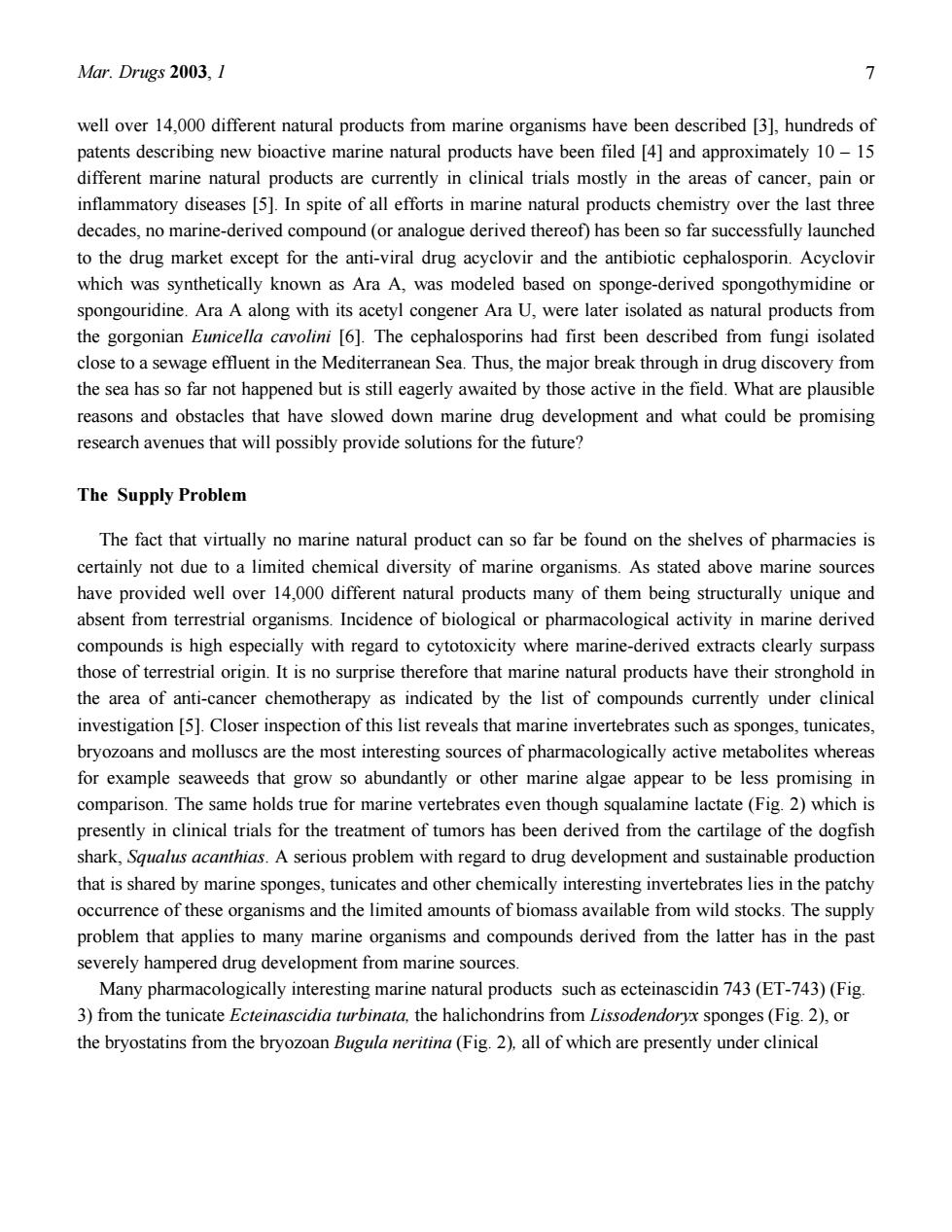正在加载图片...

Mar.Drugs 2003,1 7 well over 14,000 different natural products from marine organisms have been described [3],hundreds of patents describing new bioactive marine natural products have been filed [4]and approximately 10-15 different marine natural products are currently in clinical trials mostly in the areas of cancer,pain or inflammatory diseases [5].In spite of all efforts in marine natural products chemistry over the last three decades,no marine-derived compound(or analogue derived thereof)has been so far successfully launched to the drug market except for the anti-viral drug acyclovir and the antibiotic cephalosporin.Acyclovir which was synthetically known as Ara A,was modeled based on sponge-derived spongothymidine or spongouridine.Ara A along with its acetyl congener Ara U,were later isolated as natural products from the gorgonian Eunicella cavolini [6].The cephalosporins had first been described from fungi isolated close to a sewage effluent in the Mediterranean Sea.Thus,the major break through in drug discovery from the sea has so far not happened but is still eagerly awaited by those active in the field.What are plausible reasons and obstacles that have slowed down marine drug development and what could be promising research avenues that will possibly provide solutions for the future? The Supply Problem The fact that virtually no marine natural product can so far be found on the shelves of pharmacies is certainly not due to a limited chemical diversity of marine organisms.As stated above marine sources have provided well over 14,000 different natural products many of them being structurally unique and absent from terrestrial organisms.Incidence of biological or pharmacological activity in marine derived compounds is high especially with regard to cytotoxicity where marine-derived extracts clearly surpass those of terrestrial origin.It is no surprise therefore that marine natural products have their stronghold in the area of anti-cancer chemotherapy as indicated by the list of compounds currently under clinical investigation [5].Closer inspection of this list reveals that marine invertebrates such as sponges,tunicates bryozoans and molluscs are the most interesting sources of pharmacologically active metabolites whereas for example seaweeds that grow so abundantly or other marine algae appear to be less promising in comparison.The same holds true for marine vertebrates even though squalamine lactate(Fig.2)which is presently in clinical trials for the treatment of tumors has been derived from the cartilage of the dogfish shark,Squalus acanthias.A serious problem with regard to drug development and sustainable production that is shared by marine sponges,tunicates and other chemically interesting invertebrates lies in the patchy occurrence of these organisms and the limited amounts of biomass available from wild stocks.The supply problem that applies to many marine organisms and compounds derived from the latter has in the pas severely hampered drug development from marine sources. Many pharmacologically interesting marine natural products such as ecteinascidin 743(ET-743)(Fig 3)from the tunicate Ecteinascidia turbinata,the halichondrins from Lissodendoryx sponges(Fig.2),or the bryostatins from the bryozoan Bugula neritina(Fig.2)all of which are presently under clinical Mar. Drugs 2003, 1 7 well over 14,000 different natural products from marine organisms have been described [3], hundreds of patents describing new bioactive marine natural products have been filed [4] and approximately 10 – 15 different marine natural products are currently in clinical trials mostly in the areas of cancer, pain or inflammatory diseases [5]. In spite of all efforts in marine natural products chemistry over the last three decades, no marine-derived compound (or analogue derived thereof) has been so far successfully launched to the drug market except for the anti-viral drug acyclovir and the antibiotic cephalosporin. Acyclovir which was synthetically known as Ara A, was modeled based on sponge-derived spongothymidine or spongouridine. Ara A along with its acetyl congener Ara U, were later isolated as natural products from the gorgonian Eunicella cavolini [6]. The cephalosporins had first been described from fungi isolated close to a sewage effluent in the Mediterranean Sea. Thus, the major break through in drug discovery from the sea has so far not happened but is still eagerly awaited by those active in the field. What are plausible reasons and obstacles that have slowed down marine drug development and what could be promising research avenues that will possibly provide solutions for the future? The Supply Problem The fact that virtually no marine natural product can so far be found on the shelves of pharmacies is certainly not due to a limited chemical diversity of marine organisms. As stated above marine sources have provided well over 14,000 different natural products many of them being structurally unique and absent from terrestrial organisms. Incidence of biological or pharmacological activity in marine derived compounds is high especially with regard to cytotoxicity where marine-derived extracts clearly surpass those of terrestrial origin. It is no surprise therefore that marine natural products have their stronghold in the area of anti-cancer chemotherapy as indicated by the list of compounds currently under clinical investigation [5]. Closer inspection of this list reveals that marine invertebrates such as sponges, tunicates, bryozoans and molluscs are the most interesting sources of pharmacologically active metabolites whereas for example seaweeds that grow so abundantly or other marine algae appear to be less promising in comparison. The same holds true for marine vertebrates even though squalamine lactate (Fig. 2) which is presently in clinical trials for the treatment of tumors has been derived from the cartilage of the dogfish shark, Squalus acanthias. A serious problem with regard to drug development and sustainable production that is shared by marine sponges, tunicates and other chemically interesting invertebrates lies in the patchy occurrence of these organisms and the limited amounts of biomass available from wild stocks. The supply problem that applies to many marine organisms and compounds derived from the latter has in the past severely hampered drug development from marine sources. Many pharmacologically interesting marine natural products such as ecteinascidin 743 (ET-743) (Fig. 3) from the tunicate Ecteinascidia turbinata, the halichondrins from Lissodendoryx sponges (Fig. 2), or the bryostatins from the bryozoan Bugula neritina (Fig. 2), all of which are presently under clinical